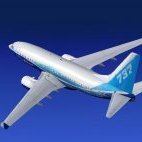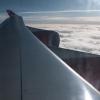
All Activity
This stream auto-updates
- Past hour
-
How can you say that? Because depiction is the same. There are just two types of clouds depicted. The question how the real clouds looked at day, right?
-
Henrik Nielsen's Global AI Ship Traffic for MSFS
peloto replied to captain420's topic in Microsoft Flight Simulator (2020)
The ideal then would be to have them in real time by our own and user license with the data provider. -
Thnx. I have a 3-metre super powerful 20 quid cable arriving later. Importantly it carries power 100W / 500mA... and it's USB C gen 3.2 (20) for data. It's designed for VR stuff apparently. No doubt overkill but it will at least remove the "limitation" of the powered-hub element. IF it improves... I'll add other stuff back into the mix until it doesn't any more. Hopefully I'll improve things. But TBH I'm thinking that running 3 SDs and a bunch of button boxes all from one app, may be pushing it a bit. I've also got Saitek panels/radio run by Spad.next ... I guess the entire USB system can only cope with so much data, before stuff starts to queue up ? Thnx !
-

Historical weather planned for MSFS 2024
F737MAX replied to abrams_tank's topic in Microsoft Flight Simulator (2020)
Ah, I see you've noticed this too. Things that I've seen called a 'waste' in my time in flight simming: Terminal interiors Aircraft cabins Wing views 3D cockpits Aircraft liveries Failures Live/real scheduled AI traffic Ground services and pushback PBR Orthographic/photoscenery terrain High resolution terrain mesh Volumetric clouds Live weather Historical weather and many more... Funny thing is, these 'wastes' of effort are rather popular and tend to become required features in new products over time! -

SU 15 Delayed again
Lonesome Cowboy Burt replied to Bobsk8's topic in Microsoft Flight Simulator (2020)
In all seriousness the amount of maybe - approximate - sometimes-pure hearsay that is regurgitated as definites and facts by just a few here is beginning to turn me off visiting so often. There are lots of knowledgeable folk here but wading through the dross from the gossipers and zealots is sometimes tiresome -

Laggy Rotaries/Dials on SD+ Best Fix ?
Dazzlercee23 replied to Gabe777's topic in AxisAndOhs Support
Yeah, I had wireless dongles for keyboard, mouse, xbox and headphones, plus yoke, throttles, rudders and SD+ on the same powered hub. With this setup the SD+ was very slow to respond to anything. Through trial and error I found that moving the headphones dongle to a native USB port completely solved the issue. -
How to update my AIRAC in ASFS? Do you know this? I use Navigraph Subscription
-
After having acquired my own TCA yoke I decided to investigate the reason for the roll axis issues reported by some of the users. The first thing to check was the roll axis sensor as some of the users were reporting a strange dependency of sensor operation on the external magnetic field (which shouldn't be the case with a properly designed sensor). So after the disassembly I was very much surprised to see the roll axis sensor to be designed around a single AH49E chip which is a simple "old-style" analog Hall-effect sensor. There is a couple of issues with this solution: 1. AH49E is reacting to a magnetic field strength variation in any direction relative to it's body. When a small round diametral- magnetized magnet is rotated close to it, the field strength change is non-linear in relation to the rotation angle. Which means that the yoke's reaction to roll axis rotation is stronger near the center and becomes weaker close to the rotation extremes. Of course it can be compensated in the sim by choosing a non-linear response curve, but in my opinion having a sensor with a non-linear response and no internal compensation for it is simply not right. 2. The magnet is not too strong, so the output signal swing for a full side-to-side yoke rotation is mush less than a sensor power supply voltage. When the yoke internal calibration is performed, the signal is- well- 'amplified" digitally within a yoke controller to match the controller's reference signal voltage swing (from 0 to full power supply voltage). Unfortunately any "noise" (magnetic or electric) that might be induced to the sensor circuit/ connecting wires (that are quite long) will be amplified as well increasing the roll axis sensitivity to the external interference. 3. As AH49E is sensing any changes in the adjacent magnetic field strength, any external ferromagnet object near the back of the yoke handle will create a disturbance in the roll axis; the same goes for the stability of the internal magnet. In some cases this might require a yoke re-calibration. My solution to this issue is the replacement of a simple Hall-effect sensor by a different type specifically designed for registering an axis rotation. In my opinion the best DIY option here is AS5600 from AMS. The main features of the chip are: 1. It is reacting to a degree of magnetic field rotation in relation to a chip's upper/ lower cover. The signal is directly proportional to the rotation angle with a very good linearity. 2. AS5600 offers a very simple internal calibration routine which adjusts the sensor's output signal swing (from 0 to power supply voltage) to a full rotational angle required. This means a much better immunity to the external "noise". 3. AS5600 is not sensitive to the magnetic field strength variations so the external ferromagnet objects do not influence the sensor operation. Also there is no need of a periodic yoke re-calibration. In practical terms the option that I've chosen was to use the ready-made AS5600 board available from Amazon or eBay (also from AliExpress). It has all the external elements needed and the size allows to fit the board into the existing opening in the roll sensor base without the need of any mechanical trimming of either the sensor or the base. The board requires soldering one additional jumper to set the correct power supply voltage. Here is the set of pictures showing the mod. After removing the existing sensor and mounting the new board the new sensor needs to be calibrated internally but it's a very simple procedure not requiring any additional tools. Having done the mod I'm quite happy with the results. If any of you are interested, I'll be happy to provide the additional details.
-
Really ? I've read the manual and quite frankly I'm none the wiser. The lack of information is letting down this app. It reads like a dictionary.
-
Hmmm... I'm currently about to try different cables and direct routing rather than using powered hubs. Been thinking it may affect it.
-

Laggy Rotaries/Dials on SD+ Best Fix ?
Dazzlercee23 replied to Gabe777's topic in AxisAndOhs Support
Never experienced that. But I have experienced the whole SD+ becoming laggy if I have my wireless headphones dongle on the same USB hub. -
Yes, it is possible and a great feature. I always stack heading and course where required. Not sure of any tutorials, but it is very straight forward.
-
Currently I do.
-
Do you use the default AS settings?
-
Thanks a lot. That sounds good.
-
And like Pilot2ATC, FSHud and Simbrief already do in MSFS. Hopefully some more developers including Fenix will implement an option to use the ASFS weather in their products soon. Regarding the winds aloft afaik the Fenix already reads them from SimBrief so these should match the ASFS weather as Simbrief already supports ASFS. I haven't noticed any issues with the Fenix after dozens of flights with ASFS.
-
Thanks for this very usefull aditional topic!
-
pmb started following April 25, 2024 MSFS Development Update
-
Right, well he is saying it "probably" needs another week.. then he says "most likely" week the 7th.. but I don't see this as a hard promise, based on posts on devsupport from asobo I am expecting 2 beta drops at minimum and that would push it beyond 7th.. R.
-
Fenix and AS get their data from different sources, however, if it's live weather the results you are going to get are pretty similar. It's a different story, obviously, if you're using historic weather. In order for this to work you should ask Fenix developers to assign AS as a data source for weather in addition to what its currently using (NOAA I would assume) - just like FSLabs does in P3D
-

Historical weather planned for MSFS 2024
-Belga- replied to abrams_tank's topic in Microsoft Flight Simulator (2020)
That's why an "VATSIM option" exists in Active Sky. When activated, AS uses the same METAR as VATSIM. -
Gabe777 started following Streamdeck Plus Dial Stacking ? and Laggy Rotaries/Dials on SD+ Best Fix ?
-
So I have 3 SD's but use the Plus as an AP in MSFS. Quite often, if I'm adjusting a dial... say for Heading ... there is a freeze and a few seconds wait, and the value has changed by 10 or 15. Are there any settings that improve this "queuing up" effect ? Thnx
-
Hy to ALL using ASFS. I am flying mainly Fenix A320 and i´m very well known with ActiveSky in P3D for several years. I have very good experiences with AxtiveSky, unfortunately due the restrictions in P3D, not with P3D as soon as volumentric clouds implemented in P3D. My questions are: Is ASFS good to use in Combination with Fenix A320? So, does Fenix handle the implemented weather well? Regarding: 1) Turbulence, Temps, Wind Requests for Climb, Cruise and Decent, Wind directions and Speed in PFD, Windshear (so, shows Fenix a normal behavior or overreacting on these wind and turbulance related topics)? 2) Is it possible to request ASFS METAR/TAF in Fenix EFB when using ASFS Live Weather? Or are these Fenix Functions INOP or are they even calling MSFS METAR/TAF? I would like to use ASFS as I think this Addon is the absolut specialist APP regarding Weather in a Flightsim. But if it is Suboptimal for me, with Addons like FENIX, then I would wait to plunge in till FENIX got updated. A feedback would be very welcome. Thanks in advance! Marcus
-
Looking youtube videos this app is like Xenviro, but xenviro has better 3D clouds both apps have historical weather and both apps send data to pilot2atc Hope in the future upgrades , active sky will improve clouds, since that i will stay with Xenviro
- Today
-
New User PMDG 737 Questions (MSFS)
FS++ replied to scmtech's topic in The Multi-Crew Experience (MCE) Support Forum
In "General" tab of MCE UI, click <More options> button In "Advanced options" panel, click <View config> button. mce.ini config file will open in Notepad. Ensure.... [OPTIONS] GroundServicesMode=GSX Should work as long as GSX is always your preferred ground services. I mean, no need for automatic switching based on detection. -
Hi. So is it possible to dial stack with the SD+ in MSFS ? I'M using Geunsrli's stuff etc and was wondering if heading, course IAS etc could all be mapped to 1 dial, by pressing the dial, to toggle between modes ? If so, are there any tutorials ? Thnx






